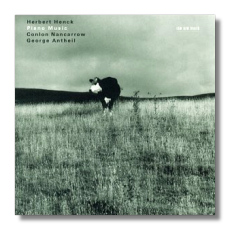
The Internet's Premier Classical Music Source
Related Links
-
Antheil Reviews
Nancarrow Reviews - Latest Reviews
- More Reviews
-
By Composer
-
Collections
DVD & Blu-ray
Books
Concert Reviews
Articles/Interviews
Software
Audio
Search Amazon
Recommended Links
Site News
 CD Review
CD Review
Nancarrow & Antheil

Piano Music
- Conlon Nancarrow:
- Three 2-Part Studies
- Prélude. Blues
- George Antheil:
- Sonatina für Radio
- Sonata #2 "The Airplane"
- Mechanisms
- A Machine
- Sonatina (Death of the Machines)
- Sonata #4 "Jazz Sonata"
- Sonata Sauvage
- (Little) Shimmy
Herbert Henck, piano
ECM New Series 1726 465829-2 DDD 40:48
The connection between Conlon Nancarrow (1912-1997) and George Antheil (1900-1959) was not immediately obvious to me, but pianist Herbert Henck's booklet notes tease it out: it's the player piano. Nancarrow's fame rests almost exclusively, of course, on his volumes of studies for that instrument. By taking the human performer out of the equation, Nancarrow was able to write music of nearly unlimited density and rhythmic complexity. I didn't know, however, that George Antheil composed music for the player piano as well. The original version of his Ballet mécanique included no fewer than 16 of those instruments, an inspiration soon whittled down by the knife of practicality and economy. It is ironic that this connection between the two composers is made in the context of a CD that contains no music for player piano. (Antheil's "Jazz Sonata" does include the instruction "like a player-piano.")
In the past year or two there has been a rebirth of interest in Antheil's music. His colorful life certainly hasn't inhibited this; his achievements included the refinement, with actress Hedy Lamarr, of radio-controlled torpedoes! (Check my other Antheil reviews on Classical Net for additional biographical information.) Henck's selection of music by Antheil appears to be the most generous currently available on CD. The music reflects his impudent intelligence (he was, after all, the "Bad Boy of Music"), his piano virtuosity, and his interest in machinery and other modern innovations, namely jazz rhythms. These works come from his European years (1922-33), when he was reviled, embraced, and then reviled again as the Nazis rose to power. (When he returned to the United States, he was unable to repeat his European successes.) Tempo indications such as "to be played as fast as possible" (in the "Airplane" sonata) and "as rapidly as it is possible to execute cleanly and with even touch and dynamics" (the "Jazz Sonata") show that Henck has his work cut out for him. He triumphs over the difficulties, however, and he convincingly animates Antheil's cocky excursions into syncopation.
Nancarrow's works for player piano have overshadowed the rest of his output, so it is good that Henck has included three brief works on this CD. The rhythmic intricacies of works such as these so frustrated flesh-and-blood pianists that Nancarrow was driven to discover the "eureka" of the player piano. Having said that, nine minutes of Nancarrow makes a lopsided CD, and the stylistic differences between Nancarrow's and Antheil's music, while not exactly jarring, exacerbate the lopsidedness. Henck, an established master in modern music of the most demanding sort, deals with Nancarrow's cruel challenges with confidence.
This recording was made in August 1999 in Frankfurt am Main's Festeburgkirche, and the engineering is satisfying; the piano is given lively sound by the venue, but there is no loss of clarity. Henck's booklet notes are generous and interesting. In contrast, the 40-minute length of this CD is not generous. Still, don't let that keep you from giving it a try – it's worth it. Just look for the cow on the cover!
Copyright © 2001, Raymond Tuttle


















